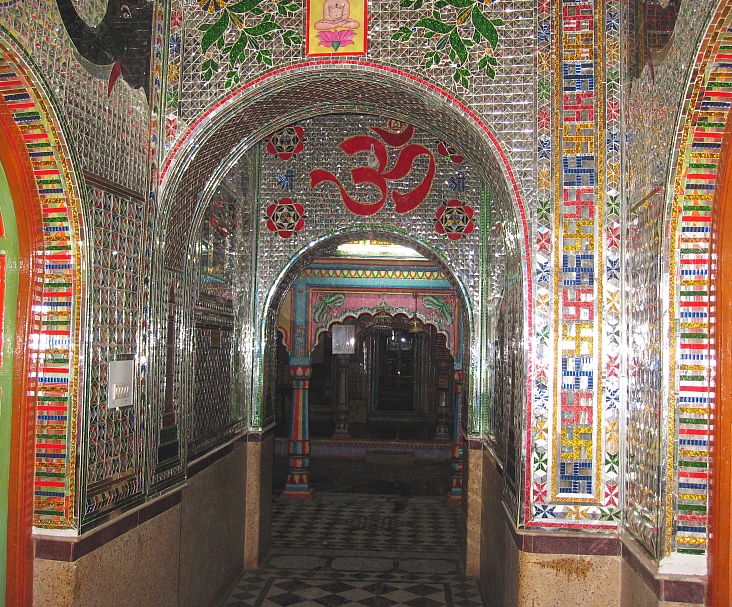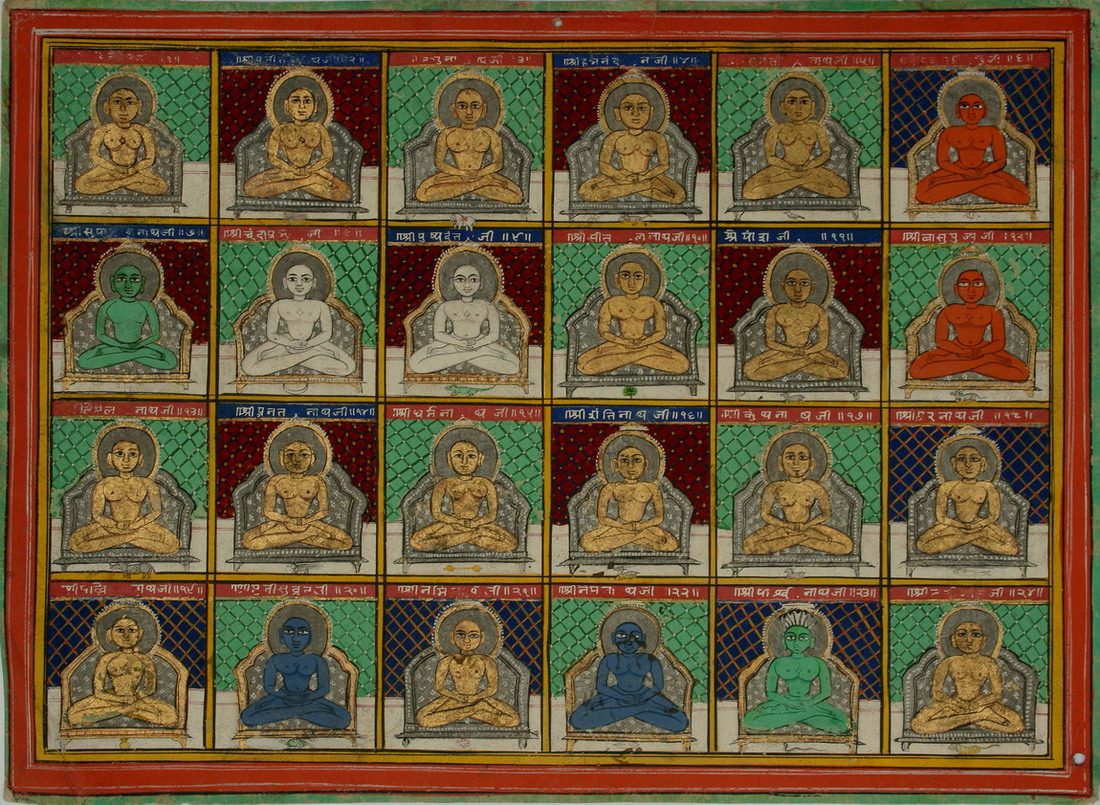|
Kanch Mandir
Kanch Mandir, literally Temple of Glass, is a famous Jain temple in Indore, built by Sir Seth Hukumchand Jain. The construction began sometime around 1903. History Sir Seth Seth Hukumchand Jain was a prominent trader and one of India's industrial pioneer. He built a mansion at Itwaria Bazar called Shish Mahal and adjacent to it the Kanch Ka Mandir, both elegantly built using a white stone. Externally, the temple is built as a medieval mansion complete with a canopied balcony and a shikhara. Structure and Interior The interior of Kanch Ka Mandir is entirely covered by glass panels and mosaics; including the floor, columns, walls and the ceilings. Seth Hukumchand hired craftsmen from Jaipur and some even from Iran to work on the temple. The ornamentation follow the old and medieval Jain style, with the major innovation being the use of multicolored glass and mirrors. In the main Garbhagriha, the idols of the Tirthankaras are flanked by mirrors on both sides, thus their images ... [...More Info...] [...Related Items...] OR: [Wikipedia] [Google] [Baidu] |
Jainism
Jainism ( ), also known as Jain Dharma, is an Indian religions, Indian religion whose three main pillars are nonviolence (), asceticism (), and a rejection of all simplistic and one-sided views of truth and reality (). Jainism traces its spiritual ideas and history through the succession of twenty-four , supreme preachers of ''dharma''. The first in the current time cycle is Rishabhadeva, who tradition holds lived millions of years ago; the 23rd is Parshvanatha, traditionally dated to the 9th century Common Era, BCE; and the 24th is Mahāvīra, Mahavira, who lived . Jainism is considered an eternal ''dharma'' with the guiding every time cycle of the Jain cosmology, cosmology. Central to understanding Jain philosophy is the concept of ''bhedavijñāna'', or the clear distinction in the nature of the soul and non-soul entities. This principle underscores the innate purity and potential for liberation within every Jīva (Jainism), soul, distinct from the physical and menta ... [...More Info...] [...Related Items...] OR: [Wikipedia] [Google] [Baidu] |
Buildings And Structures In Indore
A building or edifice is an enclosed structure with a roof, walls and windows, usually standing permanently in one place, such as a house or factory. Buildings come in a variety of sizes, shapes, and functions, and have been adapted throughout history for numerous factors, from building materials available, to weather conditions, land prices, ground conditions, specific uses, prestige, and aesthetic reasons. To better understand the concept, see ''Nonbuilding structure'' for contrast. Buildings serve several societal needs – occupancy, primarily as shelter from weather, security, living space, privacy, to store belongings, and to comfortably live and work. A building as a shelter represents a physical separation of the human habitat (a place of comfort and safety) from the ''outside'' (a place that may be harsh and harmful at times). buildings have been objects or canvasses of much artistic expression. In recent years, interest in sustainable planning and building practi ... [...More Info...] [...Related Items...] OR: [Wikipedia] [Google] [Baidu] |
Tourist Attractions In Indore
Tourism is travel for pleasure, and the commercial activity of providing and supporting such travel. UN Tourism defines tourism more generally, in terms which go "beyond the common perception of tourism as being limited to holiday activity only", as people "travelling to and staying in places outside their usual environment for not more than one consecutive year for leisure and not less than 24 hours, business and other purposes". Tourism can be domestic (within the traveller's own country) or international. International tourism has both incoming and outgoing implications on a country's balance of payments. Between the second half of 2008 and the end of 2009, tourism numbers declined due to a severe economic slowdown (see Great Recession) and the outbreak of the 2009 H1N1 influenza virus. These numbers, however, recovered until the COVID-19 pandemic put an abrupt end to the growth. The United Nations World Tourism Organization has estimated that global international tourist a ... [...More Info...] [...Related Items...] OR: [Wikipedia] [Google] [Baidu] |
Ratha Yatra
Ratha Yatra (), or chariot festival, is any public procession in a chariot. They are held annually during festivals in India, Nepal, and Sri Lanka. The term also refers to the popular annual Ratha Yatra of Puri that involves a public procession with a chariot with deities Jagannath (Vishnu avatar), Balabhadra (his brother), Subhadra (his sister), and Sudarshana Chakra (his weapon) on a ratha, which is a wooden deula-shaped chariot. Ratha Yatra processions have been historically common in Vishnu-related (Jagannath, Rama, Krishna) traditions in Hinduism across India, in Shiva-related traditions, saints and goddesses in Nepal, with Tirthankaras in Jainism, as well as tribal folk religions found in the eastern states of India. Notable Ratha Yatras in India include the Ratha Yatra of Puri, the Dhamrai Ratha Yatra in Bangladesh and the Ratha Yatra of Mahesh. Hindu communities outside India, such as in Singapore, celebrate Ratha Yatra such as those associated with Jagannat ... [...More Info...] [...Related Items...] OR: [Wikipedia] [Google] [Baidu] |
Kshamavani
Kshamavani () or "Forgiveness Day" is a day of forgiving and seeking forgiveness for the followers of Jainism. Digambaras celebrate it on the first day of '' Ashvin Krishna'' month of the lunar-based Jain calendar. Śvētāmbaras celebrate it on Samvatsari, the last day of the annual Paryushana festival. which coincides with the Chaturthi, 4th day of Shukla Paksha in the holy month of Bhadra. " Micchami Dukkadam" is the common phrase when asking for forgiveness. It is a Prakrit phrase meaning "May all the evil that has been done be fruitless". Observance On this sacred day, every member of the Jain community approaches everyone, irrespective of religion, and begs for forgiveness for all their faults or mistakes, committed either knowingly or unknowingly. Thus relieved of the heavy burden hanging over their head of the sins of yesteryears, they start life afresh, living in peaceful co-existence with others. Indeed, this day is not merely a traditional ritual, but a first st ... [...More Info...] [...Related Items...] OR: [Wikipedia] [Google] [Baidu] |
Mandala
A mandala (, ) is a geometric configuration of symbols. In various spiritual traditions, mandalas may be employed for focusing attention of practitioners and adepts, as a spiritual guidance tool, for establishing a sacred space and as an aid to meditation and trance induction. In the Eastern religions of Hinduism, Buddhism, Jainism and Shinto it is used as a map representing deities, or especially in the case of Shinto, paradises, kami or actual shrines. Hinduism In Hinduism, a basic mandala, also called a '' yantra'', takes the form of a square with four gates containing a circle with a centre point. Each gate is in the general shape of a T. Mandalas often have radial balance. A '' yantra'' is similar to a mandala, usually smaller and using a more limited colour palette. It may be a two- or three-dimensional geometric composition used in '' sadhanas'', puja or meditative rituals, and may incorporate a mantra into its design. It is considered to represent the abode ... [...More Info...] [...Related Items...] OR: [Wikipedia] [Google] [Baidu] |
Tirthankara
In Jainism, a ''Tirthankara'' (; ) is a saviour and supreme preacher of the ''Dharma (Jainism), dharma'' (righteous path). The word ''tirthankara'' signifies the founder of a ''Tirtha (Jainism), tirtha'', a fordable passage across ''Saṃsāra (Jainism), saṃsāra'', the sea of interminable birth and death. According to Jains, ''tirthankaras'' are the supreme preachers of ''dharma'', who have conquered ''saṃsāra'' on their own and made a path for others to follow. After understanding the true nature of the self or soul, the ''Tīrthaṅkara'' attains ''kevala jnana'' (omniscience). A Tirthankara provides a bridge for others to follow them from ''saṃsāra'' to ''moksha'' (liberation). In Jain cosmology, the wheel of time is divided into two halves, Utsarpiṇī', the ascending time cycle, and ''avasarpiṇī'', the descending time cycle (said to be current now). In each half of the cycle, exactly 24 ''tirthankaras'' grace this part of the universe. There have been infini ... [...More Info...] [...Related Items...] OR: [Wikipedia] [Google] [Baidu] |
Madhya Pradesh
Madhya Pradesh (; ; ) is a state in central India. Its capital is Bhopal and the largest city is Indore, Indore. Other major cities includes Gwalior, Jabalpur, and Sagar, Madhya Pradesh, Sagar. Madhya Pradesh is the List of states and union territories of India by area, second largest Indian state by area and the List of states and union territories of India by population, fifth largest state by population with over 72 million residents. It borders the states of Rajasthan to the northwest, Uttar Pradesh to the northeast, Chhattisgarh to the east, Maharashtra to the south, Gujarat to the west. The area covered by the present-day Madhya Pradesh includes the area of the ancient Avanti (India), Avanti Mahajanapada, whose capital Ujjain (also known as Avantika) arose as a major city during the second wave of Indian urbanisation in the sixth century BCE. Subsequently, the region was ruled by the major dynasties of India. The Maratha Confederacy, Maratha Empire dominated the maj ... [...More Info...] [...Related Items...] OR: [Wikipedia] [Google] [Baidu] |
Garbhagriha
A ''garbhagriha'' () is the innermost sanctuary of Hindu and Jain temples, often referred to as the "holy of holies" or " sanctum sanctorum". The term ''garbhagriha'' (literally, "womb chamber") comes from the Sanskrit words ''garbha'' for womb and ''griha'' for house. Although the term is often associated with Hindu temples, it is also found in Jain and Buddhist temples. The garbhagriha is the location of the ''murti'' (sacred image) of the temple's primary deity. This might be a murti of Shiva, as the lingam, his consort the Goddess in her consecrated image or yoni symbol, Vishnu or his spouse, or some other god in symbol or image. In the Rajarani temple in Bhubaneswar, near Puri, there is no symbol in that lightless garbhagriha. Architecture A garbhagriha started with a circular architecture like at Gudimellam temple (3rd century BCE). Later it evolved as a square (though there are exceptions), sits on a plinth, and is also at least approximately a cube. Compared ... [...More Info...] [...Related Items...] OR: [Wikipedia] [Google] [Baidu] |






